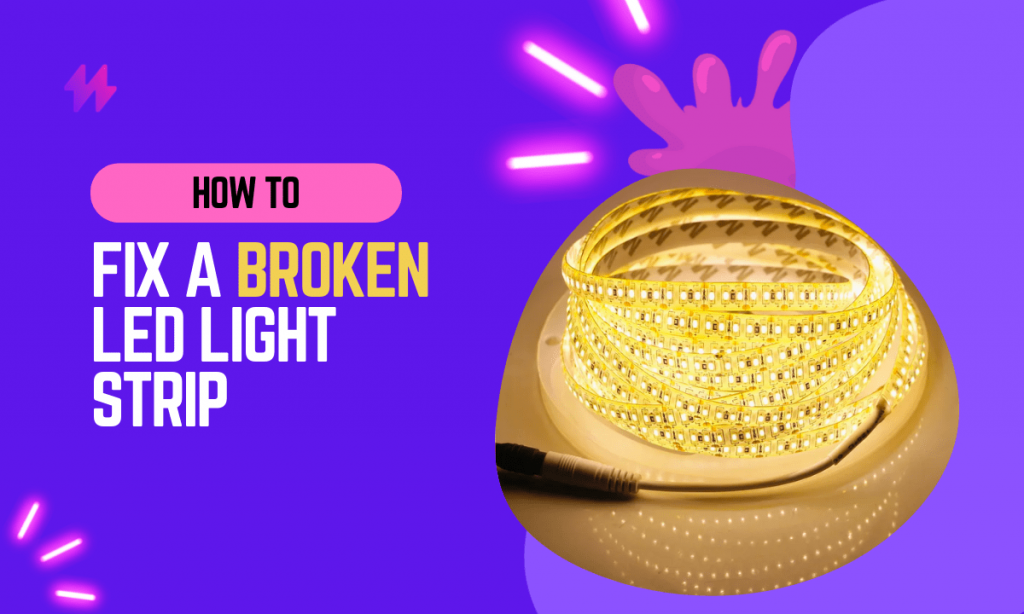Have your beloved LED light strips gone dark, leaving you in a dim and dreary space? Don’t fret just yet! Before calling in an electrician or bidding farewell to your festive ambiance, take a deep breath and embark on a troubleshooting adventure. Fixing a broken LED light strip is not as daunting as it may seem, and with a bit of patience and careful attention, you can restore your home’s radiant glow in no time.

Image: www.advancedledlights.com
LED light strips are versatile and durable lighting tools that have become increasingly popular for home décor, accent lighting, and even automotive applications. Their energy efficiency and customizable designs make them a favorite among homeowners and DIY enthusiasts alike. However, like any electrical component, LED light strips are not immune to occasional malfunctions. If your LED light strip has ceased to illuminate, don’t despair. With the right tools and a bit of electrical know-how, you can diagnose and rectify the issue, bringing your light strip back to its former glory.
Understanding LED Light Strips: A Foundation for Repair
Before delving into the repair process, it’s essential to have a basic understanding of how LED light strips operate. LED (light-emitting diode) light strips comprise numerous tiny LEDs mounted on a flexible circuit board. These LEDs emit light when an electric current passes through them, creating a continuous, glowing strip.
LED light strips are typically powered by a low-voltage direct current (DC) power supply, usually ranging from 12 volts to 24 volts. The power supply converts alternating current (AC) from your household outlet to the necessary DC voltage for the LED strip to operate.
Troubleshooting Your Broken LED Light Strip: A Systematic Approach
Now that we have a firm grasp on the basics, let’s embark on a systematic troubleshooting journey to identify and resolve the issue with your beloved LED light strip.
1. Verify the Power Source: Is the Power Flowing?
Begin your troubleshooting by inspecting the power source. Ensure the LED light strip is securely plugged into a working electrical outlet. You can use a simple electrical tester or multimeter to confirm the presence of voltage at the outlet. If the outlet seems faulty, try connecting the LED strip to a different outlet to rule out any power-related issues.

Image: ledlightstation.com
2. Examine the LED Driver: The Heart of the Light Show
The LED driver, or power supply, is the unsung hero behind the operation of your LED light strip. If the power source seems to be functioning correctly, direct your attention to the LED driver. Check for any loose connections or visible damage to the unit. If possible, test the LED driver with a multimeter to ensure it’s outputting the correct voltage for your LED strip.
3. Inspect the LED Strip: A Visual Examination for Clues
With the power source and LED driver seemingly in order, it’s time for a closer look at the LED strip itself. Unplug the light strip from the power source for safety reasons before proceeding with this step.
Visually inspect the entire length of the LED strip, paying close attention to any visible cuts, breaks, or discoloration in the copper conductors. These subtle clues can point you toward the exact location of the issue.
4. Test Individual LEDs: Isolating the Problem Child
If you haven’t been able to pinpoint the issue through visual inspection, it’s time to adopt a more meticulous approach by testing individual LEDs along the strip. Using a multimeter set to the diode test function, gently touch the probes to the positive and negative terminals of each LED. A properly functioning LED should illuminate briefly when the probes make contact.
This systematic testing will help you identify any faulty LEDs that may be causing the entire strip to malfunction. Mark these faulty LEDs for future replacement.
5. Repairing Broken LED Strip: A Surgical Intervention
Once you’ve identified the faulty LEDs, it’s time to don your surgeon’s cap and perform a delicate repair. Gather your tools, which should include a soldering iron, solder, wire strippers, and heat shrink tubing.
Carefully cut the damaged section of the LED strip, ensuring you leave a small amount of excess wire on either side of the cut. Strip the ends of the wires just enough to expose the copper conductors.
With a steady hand, solder the corresponding wires together, matching the positive and negative terminals. Allow the solder joints to cool completely before applying heat shrink tubing to insulate and protect the connections.
How To Fix Broken Led Light Strip
6. Reconnect, Test, and Celebrate: The Final Act
With the repair complete, it’s time to reconnect the LED strip to the power source and eagerly anticipate the moment of